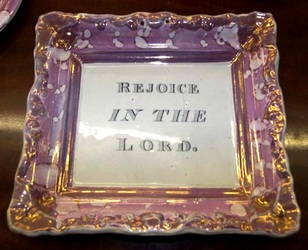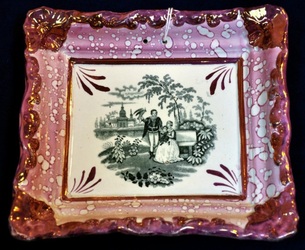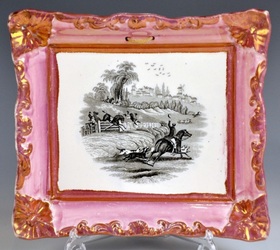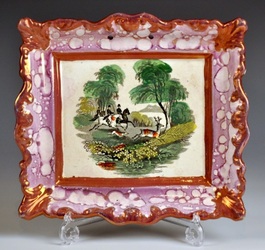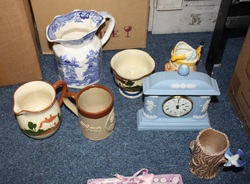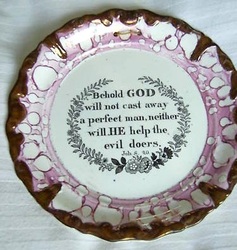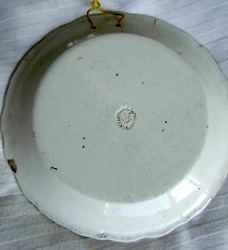|
9/29/2010 0 Comments Plaques with 'scalloped' cornersThanks to Ian Holmes for the two photographs below. The top left plaque has a Robert Maling (Tyneside) impressed mark. The top right plaque has a Moore & Co (Wearside) impressed mark. The four plaques below have no makers' marks. All the plaques have what I've previously referred to as scalloped corners – they are rounded and vaguely shell-like. The Moore & Co plaque is larger and clearly comes from a different mould. If a mould is taken from an existent object, the objects produced from the secondary mould will be smaller than the original, as the clay shrinks during firing (this happens with Staffordshire figures reproduced that way). However, I can't assert with any confidence that the Maling plaques were produced from a secondary mould of a Moore & Co plaque. It would have been easy enough for either pottery to make a copy from scratch (think about the many mould variations of the more common bordered plaques), and my guess is that the Maling plaque (top left) is older than the Moore & co plaque (top right). The Moore & Co version (top of the pile in the photo below) is shallower (flatter). Ian and I have both wondered whether all of the smaller versions of these plaques can be attributed to Maling. Maling was renowned for decorating items using green enamels (see many examples on the Maling plaques page). Another tentative link is provided by the two plaques below. I recently purchased the unmarked plaque on the left. The right plaque, though also unmarked, is of a form often attributed to Maling. The only fly in the ointment of our efforts to attribute all the smaller, 'scalloped-cornered' plaques to Maling, is the plaque below. It has the as yet unidentified printed mark 'B. & Co.'. So not Maling. Ian has found a printed mark 'I B & Co' for Bell at the Albion Pottery (also Tyneside). So perhaps it is Bell & Co. I'd love to hear from anyone with a marked plaque of this smaller Maling-type form. Even if the mark is Maling.
0 Comments
Thanks to Dick Henrywood for looking at the Plaque dates page. He writes: The only bit I would question is the Moore & Co. titled marks with numbers 48, 49 and 50. You seem to have assumed they are date codes for 1848 etc, but in my experience such numbers are pattern numbers. [...] The North-East potteries in particular tended to use pattern numbers in their marks. The thing in your favour is the California gold rush of 1848/49 onwards! I've acknowledged his point by tempering my assertions on the dates page. Regardless of whether the numbers refer to years or patterns, you'd expect their places on the Plaque dates page to remain the same. We know that the 'California 48' plaque was produced circa 1848 in response to the 'gold rush'. If 'Waverley 49' and 'Sporting 50' were assigned the next pattern numbers, we might reasonably expect them to be made shortly after that date. (See the Landscapes page for photos of the plaques and all 3 printed marks.) But I'm still clinging to my assumption that the numbers are dates. Why? There are two versions of the 'Sporting' printed mark (and the Waverley mark also). The first one, without the number '50', appears on Moore & Co plaques associated with the 1840s (see top two photos). If '50' denotes the pattern number, why doesn't it appear on the earlier Sporting plaques? I suppose it's possible that circa 1848 Moore & Co decided to number all their patterns currently in production. (I suggest that year because, unlike 'Waverley' and 'Sporting', I've never seen a 'California' without the number '48'.)
Whereas 'California 48' and 'Waverley 49' apply to one specific transfer, 'Sporting 50' applies to a series. Four different sporting transfers can be found with that number, and it appears on both circular and rectangular plaques. I don't know enough about pattern numbering, to judge whether this is significant. Moore & Co made other plaques with printed marks around the same time, which don't have a number. See the 'Cuyp' plaques on the Landscapes page, or 'The Bottle' series (circa 1847). That some contemporary plaques would have numbers and others not, seems more logical if the numbers represent years rather than patterns. The final burning question in my mind is this... if the numbers denote patterns, what happened to patterns number 1–47? If anyone knows of other Moore & Co wares with printed numbers, please get in touch. 9/21/2010 0 Comments Pot luckSome plaques you have to work a little harder for than others. Fellows listed a 'lustre plaque a/f' in amongst a box of other things, guide price circa £40–60. I didn't have high expectations when I requested photos. So I was amazed to receive the picture below. I have transcribed the verse on the poetic verses page. The condition report said the plaque had a chip (behind the ribbon in the photo), but couldn't guarantee its condition after the viewing, with hordes of people rummaging through the boxes! Not wanting to draw attention to the lot, because they might have posted photos on the website, I waited nearly a whole month before sending my bid of just over £200. I got confirmation the bid had been registered. What could go wrong!
The box sold for £65 and I posted a celebratory piece on this blog. But when I rang the following day to pay, I was told my bid on lot 477 had been transcribed incorrectly, and recorded as lot 447. The buyer had paid and taken the box home. There was nothing they could do. To give Fellows their due, they were sincerely apologetic. My indomitable friend Myrna suggested I ask the auction house to contact the buyer, explain what had happened, and say I was interested in buying the plaque. Fellows were extremely helpful and contacted the buyer twice on my behalf. The buyer eventually agreed to sell it for £100, so we both benefitted from the arrangement (the postage and packing on the box to London would have cost around £40). The plaque arrived today and is great. Well worth the extra grey hairs I gained securing its purchase. 9/13/2010 0 Comments Circular plaque with anchor markI've mentioned before that I've kept a spreadsheet of which Dixon marks appear on which plaques. The evidence suggests that the 'Dixon, Phillips and Co' anchor mark was used between 1834–1850. Whereas the 'Dixon Co' mark was used from 1851–1865. See the new Plaque dates page for more details. The plaque above, recently sold on eBay, is the first circular plaque I've recorded with the anchor mark. It seems likely that it was made in the late 1840s. We know that Moore & Co were making similar circular plaques with 'Sporting' scenes about that time.
|
AuthorStephen Smith lives in London, and is always happy to hear from other collectors. If you have an interesting collection of plaques, and are based in the UK, he will photograph them for you. Free advice given regarding selling and dispersal of a collection, or to those wishing to start one. Just get in touch... Archives
February 2022
AcknowledgementsThis website is indebted to collectors, dealers and enthusiasts who have shared their knowledge or photos. In particular: Ian Holmes, Stephen Duckworth, Dick Henrywood, Norman Lowe, Keith Lovell, Donald H Ryan, Harold Crowder, Jack and Joyce Cockerill, Myrna Schkolne, Elinor Penna, Ian Sharp, Shauna Gregg at the Sunderland Museum, Keith Bell, Martyn Edgell, and Liz Denton.
|


